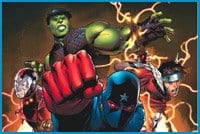Disaster leaves the world without its mightiest heroes until teen superheroes step up to the plate. Young Avengers is Marvel Comics’ newest hit. Written by TV writer Allan Heinberg (Party Of Five, Sex In The City, The OC) and drawn by Jimmy Cheung, Young Avengers features two openly gay characters in main roles, as well a black male and two female leads — all considered risks in today’s unstable comics market.
“I didn’t think anyone was going to read the book… at all,” says Heinberg. “Not because of its cast, but because of its title and premise.” But Young Avengers, which launched late last year, quickly proved popular. “I’ve been completely astonished and, frankly, heartened by the readership’s support,” says Heinberg. “Not just of the book itself but of its diverse cast.”
The TV series The OC is sprinkled with references to comics. But that was the extent of Heinberg’s experience when it came to pitching concepts to Marvel. “There were no guidelines whatsoever. Joe [Quesada, Marvel’s editor-in-chief] told me I could use existing characters, create my own… whatever I wanted to do.”
The gay characters he created are Hulkling and Wiccan. “Hulkling and Wiccan’s sexuality was part of the initial pitch, but I’d intended to deal with it very subtly throughout the first year. It wasn’t until we received a number of positive letters about a single panel of flirtatious banter between them in Young Avengers #1 that I called Marvel and asked if we could just address their sexuality openly,” says Heinberg.
Editor Tom Brevoort recalls the day Heinberg made his pitch: “He’d worked everything out to such a degree and such thoughtfulness that everybody was impressed, not just with the characters but with the storylines, the twists and reversals,” says Brevoort. “Originally, Allan pitched Hulkling as a female character using her shape-changing abilities to pose as a man. I suspect this was as close as Allan felt he could get to depicting an openly gay relationship in a Marvel comic. But as we got underway… he started to have second thoughts and approached me about maintaining Hulkling and Wiccan as two involved male characters.”
“Mostly I just wanted to write characters I’d be interested in reading about,” says Heinberg. “Their race, their sexuality — that stuff is great texture, but it’s no substitute for story or for true character.
“I think if you tell involving stories about characters readers care about, their diversity ceases to be an issue. Its just part of the fabric of the book and of the Marvel universe.”
“The hurtles today content-wise are the same kinds of hurtles that existed in the past, only the specifics of the subject matter have changed,” says Brevoort. “Once, it was unthinkable that you’d have a black superhero. Now there are dozens of them. The question of how well they represent that portion of the demographic is another discussion entirely.
“There is still a significant portion of this country that remains uncomfortable with the idea of homosexuality, and those people were upset to find such a situation depicted in one of our comics,” says Brevoort. “But at the same time, there was an outpouring of support from those who desired for a long time to see such a relationship portrayed in the comics. So it’s the same as any other subject matter that might prove sensitive: You try to handle it tastefully, avoid sensationalism and realize that there are always going to be those who won’t like what you’re doing.”
“I’ve always considered comics to be a medium where diversity is celebrated — especially at Marvel,” says Heinberg. “After all, that’s what the X-Men have always been about. In fact, Marvel’s most popular characters are usually outsiders who strive to overcome society’s prejudices — and their own self-loathing — and end up becoming true heroes as a result. Young Avengers is just a part of a long-standing tradition at Marvel that I hope will never end.”

 Why you can trust Xtra
Why you can trust Xtra


